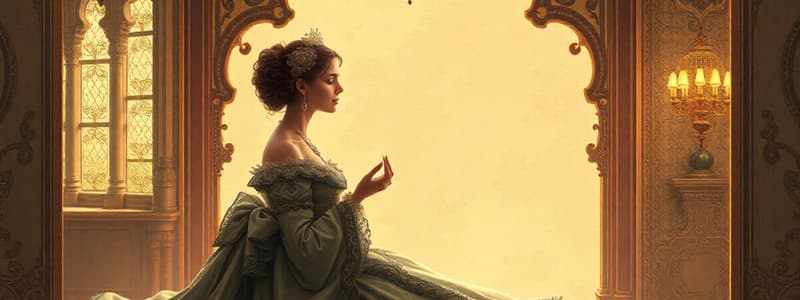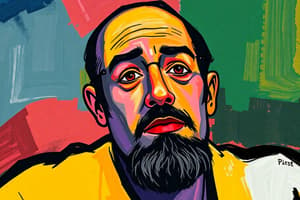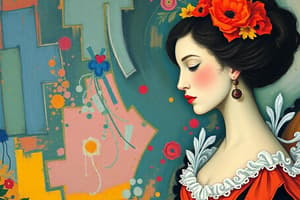Podcast
Questions and Answers
Which poetic device is central to revealing the Duke's character in 'My Last Duchess'?
Which poetic device is central to revealing the Duke's character in 'My Last Duchess'?
- Iambic pentameter
- Dramatic monologue (correct)
- Enjambment
- Rhyming couplets
What does the Duke's act of keeping the Duchess's portrait behind a curtain primarily symbolize?
What does the Duke's act of keeping the Duchess's portrait behind a curtain primarily symbolize?
- His need for control and possessiveness (correct)
- His desire to protect her image from unworthy eyes
- His respect for her memory
- His artistic sensibility and appreciation for privacy
How does the Duke's perception of the Duchess's behavior reveal his own character?
How does the Duke's perception of the Duchess's behavior reveal his own character?
- It shows his genuine grief and sense of loss.
- It highlights his humility and understanding.
- It demonstrates his capacity for forgiveness and empathy.
- It exposes his arrogance and need for control. (correct)
What is the significance of the Duke mentioning Fra Pandolf when discussing the portrait of his last duchess?
What is the significance of the Duke mentioning Fra Pandolf when discussing the portrait of his last duchess?
In 'My Last Duchess', what does the Duke's inability to 'stoop' suggest about his personality?
In 'My Last Duchess', what does the Duke's inability to 'stoop' suggest about his personality?
How does the poem's setting in Ferrara contribute to understanding the Duke's character and motivations?
How does the poem's setting in Ferrara contribute to understanding the Duke's character and motivations?
In the line 'I gave commands; Then all smiles stopped together,' what does this imply about the Duke's actions?
In the line 'I gave commands; Then all smiles stopped together,' what does this imply about the Duke's actions?
What is the primary effect of Browning's use of enjambment in 'My Last Duchess'?
What is the primary effect of Browning's use of enjambment in 'My Last Duchess'?
The Duke's reference to Neptune taming a sea-horse at the end of 'My Last Duchess' serves primarily to:
The Duke's reference to Neptune taming a sea-horse at the end of 'My Last Duchess' serves primarily to:
How does the historical context of arranged marriages influence the reader’s understanding of the poem?
How does the historical context of arranged marriages influence the reader’s understanding of the poem?
If the Duke is described as a collector, what is he trying to collect?
If the Duke is described as a collector, what is he trying to collect?
What is the impact of not knowing what happened to the last duchess?
What is the impact of not knowing what happened to the last duchess?
What is the use of the word 'my' in the title?
What is the use of the word 'my' in the title?
What does the line 'as if she were alive' imply?
What does the line 'as if she were alive' imply?
What is the Duke's opinion on the Duchess's appreciation of small things?
What is the Duke's opinion on the Duchess's appreciation of small things?
What is the purpose of the Duke speaking to the envoy?
What is the purpose of the Duke speaking to the envoy?
What does the Duke not like about the Duchess?
What does the Duke not like about the Duchess?
What can we tell about the Duke from the fact he says 'which I have not.'?
What can we tell about the Duke from the fact he says 'which I have not.'?
What tone is the poem written in?
What tone is the poem written in?
What does the Duke think about smiling?
What does the Duke think about smiling?
What themes does the Duke’s monologue explore?
What themes does the Duke’s monologue explore?
What does the Duke giving commands imply?
What does the Duke giving commands imply?
What is the role of the envoy in 'My Last Duchess'?
What is the role of the envoy in 'My Last Duchess'?
Which element of the poem 'My Last Duchess' is most effective in creating a sense of dramatic irony?
Which element of the poem 'My Last Duchess' is most effective in creating a sense of dramatic irony?
How does the Duke's focus on art and material possessions reflect his inner self?
How does the Duke's focus on art and material possessions reflect his inner self?
What does the Duke mean when he says his 'object' is the Count's daughter?
What does the Duke mean when he says his 'object' is the Count's daughter?
What is the effect of Browning's choice to write the poem as a dramatic monologue?
What is the effect of Browning's choice to write the poem as a dramatic monologue?
How does the poem’s structure contribute to the development of the Duke’s character?
How does the poem’s structure contribute to the development of the Duke’s character?
How does the rhyme scheme of 'My Last Duchess' (AABB) contribute to the poem's overall effect?
How does the rhyme scheme of 'My Last Duchess' (AABB) contribute to the poem's overall effect?
What is a key message of 'My Last Duchess'?
What is a key message of 'My Last Duchess'?
What is the likely fate of the Duke's next wife?
What is the likely fate of the Duke's next wife?
Why did the Duke not tell the Duchess of his dissatisfaction?
Why did the Duke not tell the Duchess of his dissatisfaction?
In what century did Robert Browning write this poem?
In what century did Robert Browning write this poem?
Who employs the envoy??
Who employs the envoy??
What is the purpose of the Duke pointing out the statue of Neptune taming a seahorse
What is the purpose of the Duke pointing out the statue of Neptune taming a seahorse
What historical figure is the Duke based on?
What historical figure is the Duke based on?
Why is it called a dramatic monologue
Why is it called a dramatic monologue
Lucrezia de Medici married the Duke when she was how old?
Lucrezia de Medici married the Duke when she was how old?
What is a dowry?
What is a dowry?
Flashcards
Robert Browning
Robert Browning
English poet, famous for dramatic monologues.
Dramatic Monologue
Dramatic Monologue
Speech given by one character, like a scene from a play.
Speaker Identity
Speaker Identity
Duke Alfonso II, ruler of Ferrara, Italy from 1559-1597.
Poem's Message
Poem's Message
Signup and view all the flashcards
My Last Duchess
My Last Duchess
Signup and view all the flashcards
As if she were alive
As if she were alive
Signup and view all the flashcards
Fra Pandolf reference
Fra Pandolf reference
Signup and view all the flashcards
Symbolism of curtain
Symbolism of curtain
Signup and view all the flashcards
Earnest glance
Earnest glance
Signup and view all the flashcards
Husband's presence
Husband's presence
Signup and view all the flashcards
Spot of joy
Spot of joy
Signup and view all the flashcards
Too Soon Made Glad
Too Soon Made Glad
Signup and view all the flashcards
Her looks went everywhere
Her looks went everywhere
Signup and view all the flashcards
Duchess' Preference
Duchess' Preference
Signup and view all the flashcards
Nine-hundred-years-old name
Nine-hundred-years-old name
Signup and view all the flashcards
Sort of Trifling
Sort of Trifling
Signup and view all the flashcards
Even had you skill in speech
Even had you skill in speech
Signup and view all the flashcards
Exceed the mark
Exceed the mark
Signup and view all the flashcards
I choose never to stoop
I choose never to stoop
Signup and view all the flashcards
I gave commands
I gave commands
Signup and view all the flashcards
All smiles stopped
All smiles stopped
Signup and view all the flashcards
Is my object
Is my object
Signup and view all the flashcards
Sculpture symbolism
Sculpture symbolism
Signup and view all the flashcards
Taming a sea-horse
Taming a sea-horse
Signup and view all the flashcards
Study Notes
- Robert Browning (1812 – 1889) was an English poet known for dramatic monologues.
Background
- The poem is based on Duke Alfonso II, who ruled Ferrara in northern Italy from 1559-1597.
- Alfonso's first wife was Lucrezia de Medici, who married him at 15 and died two years later, in 1561, with suspected poisoning.
- The poem is set in 1564, three years after Lucrezia's death, as a negotiator arrives from the Count of Tyrol to arrange the Duke's next marriage.
- Fra Pandolf, the artist who painted Lucrezia’s picture, was a celebrated portrait painter in real life.
Summary
- The poem features the Duke of Ferrara showing a portrait of his deceased wife to a man who has come to arrange his marriage to another woman.
- The Duke's description of his first wife suggests a dreadful fate befell her.
Message
- Powerful people treat others as objects.
Analysis
- The poem is a dramatic monologue, delivered by the Duke of Ferrara to a gentleman about his late wife.
- The monologue is a dramatic scene set in a specific time and place.
- The form is used to construct convincing characters by revealing their identities through their words.
- The dramatic monologue encourages the reader to read between the lines to find the truth.
- The poem has one long verse, written in iambic pentameter with rhyming couplets, and with enjambment for a natural speech effect.
- The title, "My Last Duchess," indicates the Duke's possessiveness and hints at a callous attitude toward women.
- The setting, "Ferrara," roots the poem in history.
First Lines
- The poem begins with the Duke pointing out a portrait of his deceased wife, looking "as if she were alive."
- The Duke mentions the artist, "Fra Pandolf," showcasing the Duke's tendency to boast.
Control
- The Duke explains that "none puts by the curtain I have drawn for you but I."
- The curtain symbolizes the Duke's possessiveness and need for control, alarming the reader.
The Duchess
- The Duke describes the face in the picture as having an "earnest glance," suggesting she was diffident and serious.
- The Duchess’s anxious look makes the reader consider how unfairly her husband treated her to look so solemn at such a young age.
- The Duke's statement that the Duchess was not made happy only by his "husband's presence" reveals his controlling nature.
- The Duke's expectation was that his wife should only enjoy his company and have no other pleasures in life.
Spot of Joy
- The Duke mentions "perhaps Fra Pandolf chanced to say 'Her mantle laps over my lady's wrist too much'," and the 'spot of joy'
- The Duke uses “perhaps” because he is speculating that the Duchess committed adultery.
- "Spot of joy" is a metaphor describing a look of pleasure as a "spot," something small and tainted, implying the Duke dislikes his wife's happiness.
Character
- The Duke describes his wife as "Too soon made glad, Too easily impressed," turning her positive traits against her, seeming paranoid and unfair.
- The Duke expresses that she "liked whate’er She looked on, and her looks went everywhere," implying his desire to control what she saw.
- Sight is a recurring theme, encouraging readers to look beneath the surface and judge the Duke's behavior.
Materialism
- The Duke states "twas all one" and everything his wife saw was treated with equal respect and appreciation.
- The Duke is annoyed that she likes sunsets, fruit, and animals as she does not value expensive things, implying he is materialistic and elitist.
Status
- The Duke explains she ‘thanked men... as if she ranked my gift of a nine-hundred-years-old name With anybody's gift’.
- The Duke believes his wife should be grateful for his name, indicating that she is now in his possession.
- The Duke thinks his wife only values his status as much as her mule which seems to irritate him.
- The Duke asks ‘who'd stoop to blame This sort of trifling?’
- The word ‘trifling’ means treating him as though he is unimportant, diminishing the Duke.
- The Duke is too proud to lower himself to his wife and dislikes her happy attitude to life.
Digression
- The Duke says ‘Even had you skill in speech – (which I have not.)’
- The phrase in brackets shows that he claims not to be able to speak well, but the Duke clearly likes the sound of his own voice very much.
Strong Language
- The Duke thought about telling his wife ‘Just this or that in you disgusts me; here you miss or there exceed the mark’.
- The Duke uses very strong language to describe his wife's attitude and judges his wife very harshly as though she were a servant rather than a partner.
Superior Status
- The Duke believes ‘E’en then would be some stooping; And I choose never to stoop’.
- The Duke repeats the word ‘stoop’ to emphasise his belief that speaking to his wife would involve him losing his superior status or bowing down to her, and he is not prepared to do this.
Commands
- The Duke explains that as his wife smiles at everyone with ‘Much the same smile’.
- Because he wants her to smile at him differently he issues ‘I gave commands’.
- The word ‘commands’ means he treats her like a servant or slave to order about.
- After this, ‘all smiles stopped’. His wife is clearly upset.
- At that moment the Duchess’s smiles stopped, happiness died, and, presumably, her life ended.
Murder
- The Duke changes his subject and says ‘Will’t please you rise?’
- The change of direction denotes the moment when the Duchess’s smiles stopped, happiness died, and, presumably, her life ended.
- A man as controlling and powerful as the Duke could easily have his wife murdered because she ceased to please him, and ‘all smiles stopped’ could hint that the Duke had his wife killed because he as jealous of other men.
Dowry
- The Duke moves on to the business he has with the ambassador.
- He says the Count will give him a ‘dowry’ with his ‘fair daughter,’ highlighting formal arrangements when women were possessions.
- Frighteningly, the Duke says the Count’s daughter ‘is my object’ as women are objectified and dehumanised.
Neptune
- The Duke ends by pointing out another one of his valuable belongings – it is a sculpture.
- The Duke directs the ambassador to ‘Notice Neptune, though, Taming a sea-horse’.
- Neptune is a powerful male figure, like the Duke, he is controlling a 'sea-horse' - delicate creatures, like the Duchess.
- The sculpture symbolizes the Duke's desire to overpower women.
- The statue was ‘cast in bronze for me!’ ending the poem with metal and the Duke concluding that he only likes things made especially to please him.
Studying That Suits You
Use AI to generate personalized quizzes and flashcards to suit your learning preferences.




